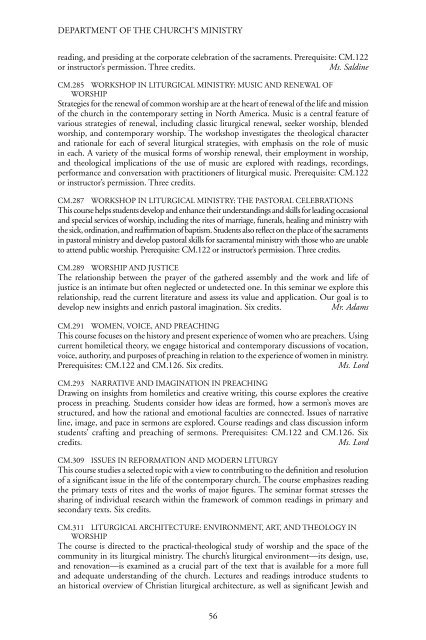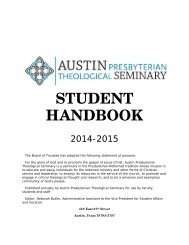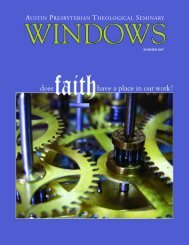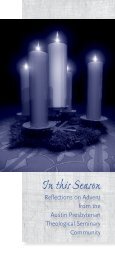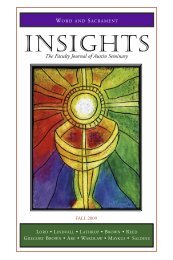Catalogue 2008 Book - Austin Presbyterian Theological Seminary
Catalogue 2008 Book - Austin Presbyterian Theological Seminary
Catalogue 2008 Book - Austin Presbyterian Theological Seminary
Create successful ePaper yourself
Turn your PDF publications into a flip-book with our unique Google optimized e-Paper software.
DEPARTMENT OF THE CHURCH’S MINISTRY<br />
reading, and presiding at the corporate celebration of the sacraments. Prerequisite: CM.122<br />
or instructor’s permission. Three credits. Ms. Saldine<br />
CM.285 WORKSHOP IN LITURGICAL MINISTRY: MUSIC AND RENEWAL OF<br />
WORSHIP<br />
Strategies for the renewal of common worship are at the heart of renewal of the life and mission<br />
of the church in the contemporary setting in North America. Music is a central feature of<br />
various strategies of renewal, including classic liturgical renewal, seeker worship, blended<br />
worship, and contemporary worship. The workshop investigates the theological character<br />
and rationale for each of several liturgical strategies, with emphasis on the role of music<br />
in each. A variety of the musical forms of worship renewal, their employment in worship,<br />
and theological implications of the use of music are explored with readings, recordings,<br />
performance and conversation with practitioners of liturgical music. Prerequisite: CM.122<br />
or instructor’s permission. Three credits.<br />
CM.287 WORKSHOP IN LITURGICAL MINISTRY: THE PASTORAL CELEBRATIONS<br />
This course helps students develop and enhance their understandings and skills for leading occasional<br />
and special services of worship, including the rites of marriage, funerals, healing and ministry with<br />
the sick, ordination, and reaffi rmation of baptism. Students also refl ect on the place of the sacraments<br />
in pastoral ministry and develop pastoral skills for sacramental ministry with those who are unable<br />
to attend public worship. Prerequisite: CM.122 or instructor’s permission. Three credits.<br />
CM.289 WORSHIP AND JUSTICE<br />
The relationship between the prayer of the gathered assembly and the work and life of<br />
justice is an intimate but often neglected or undetected one. In this seminar we explore this<br />
relationship, read the current literature and assess its value and application. Our goal is to<br />
develop new insights and enrich pastoral imagination. Six credits. Mr. Adams<br />
CM.291 WOMEN, VOICE, AND PREACHING<br />
This course focuses on the history and present experience of women who are preachers. Using<br />
current homiletical theory, we engage historical and contemporary discussions of vocation,<br />
voice, authority, and purposes of preaching in relation to the experience of women in ministry.<br />
Prerequisites: CM.122 and CM.126. Six credits. Ms. Lord<br />
CM.293 NARRATIVE AND IMAGINATION IN PREACHING<br />
Drawing on insights from homiletics and creative writing, this course explores the creative<br />
process in preaching. Students consider how ideas are formed, how a sermon’s moves are<br />
structured, and how the rational and emotional faculties are connected. Issues of narrative<br />
line, image, and pace in sermons are explored. Course readings and class discussion inform<br />
students’ crafting and preaching of sermons. Prerequisites: CM.122 and CM.126. Six<br />
credits. Ms. Lord<br />
CM.309 ISSUES IN REFORMATION AND MODERN LITURGY<br />
This course studies a selected topic with a view to contributing to the defi nition and resolution<br />
of a signifi cant issue in the life of the contemporary church. The course emphasizes reading<br />
the primary texts of rites and the works of major fi gures. The seminar format stresses the<br />
sharing of individual research within the framework of common readings in primary and<br />
secondary texts. Six credits.<br />
CM.311 LITURGICAL ARCHITECTURE: ENVIRONMENT, ART, AND THEOLOGY IN<br />
WORSHIP<br />
The course is directed to the practical-theological study of worship and the space of the<br />
community in its liturgical ministry. The church’s liturgical environment—its design, use,<br />
and renovation—is examined as a crucial part of the text that is available for a more full<br />
and adequate understanding of the church. Lectures and readings introduce students to<br />
an historical overview of Christian liturgical architecture, as well as signifi cant Jewish and<br />
56


